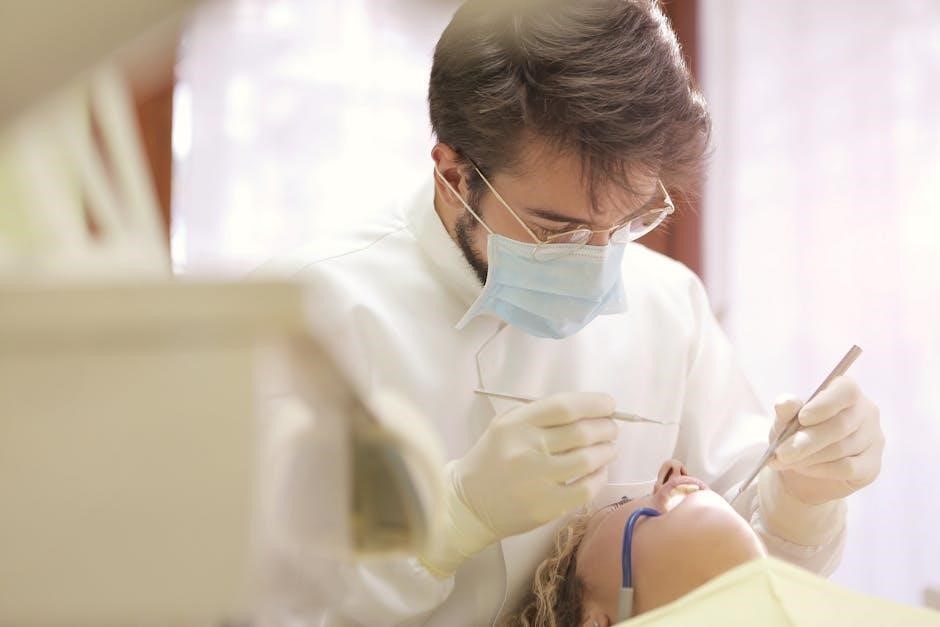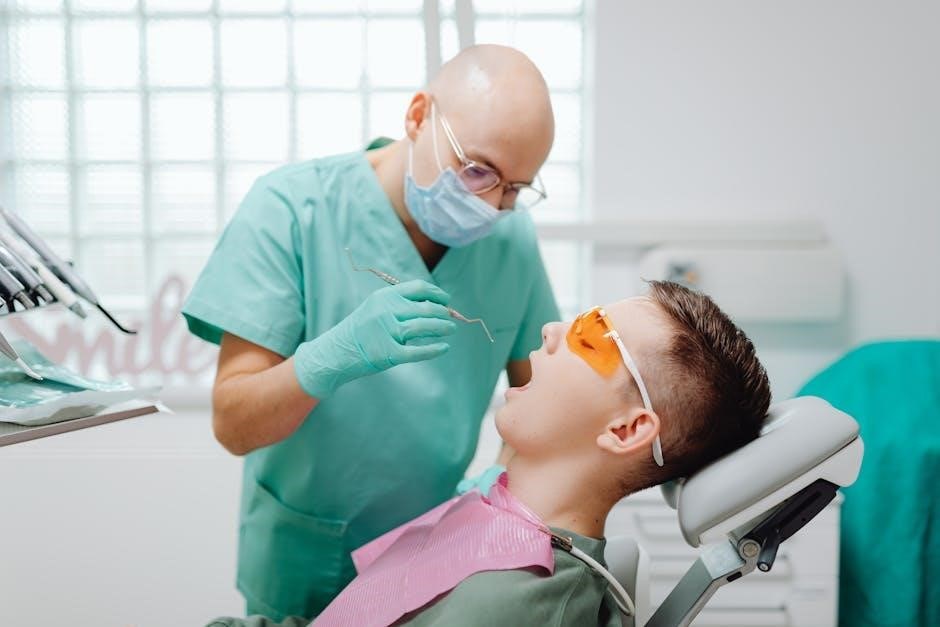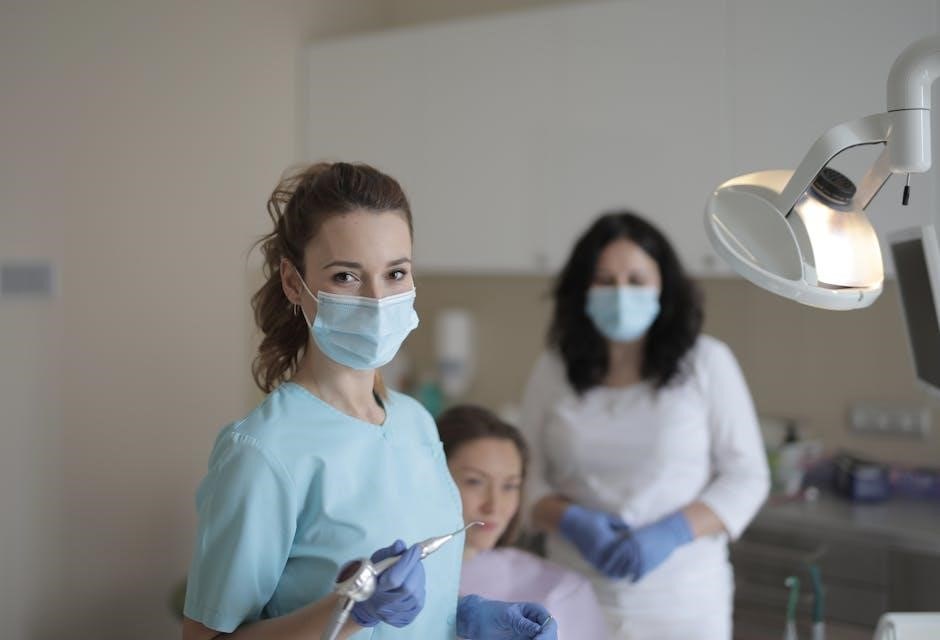The oral mechanism examination is a systematic assessment of facial and oral structures, crucial for evaluating speech, swallowing, and orofacial functions. It identifies potential disorders and guides interventions effectively.
1.1 Purpose and Importance of the Exam
The oral mechanism examination is conducted to assess the structural and functional integrity of the oral and facial mechanisms. Its primary purpose is to identify abnormalities or deficits that may contribute to speech, swallowing, or other orofacial disorders. By evaluating key components such as facial symmetry, jaw movement, tongue mobility, and lip function, the exam provides valuable insights into potential issues. It is particularly important for diagnosing speech sound disorders, dysarthria, and dysphagia. Early detection of these conditions enables timely intervention, improving outcomes for individuals with communication or swallowing challenges. The exam also serves as a foundation for developing targeted treatment plans, making it an essential tool in speech-language pathology and related fields. Its comprehensive yet efficient nature ensures that clinicians can address underlying mechanisms effectively, promoting better functional outcomes for clients.
1.2 Key Components of the Oral Mechanism
The oral mechanism examination focuses on evaluating several critical structures and functions within the oral cavity and face. These include facial symmetry, jaw movement, and alignment, as well as the condition and arrangement of the teeth. Lip and tongue mobility are assessed to determine their role in speech production and swallowing. The hard and soft palates are examined for structural integrity and function, while the pharynx is evaluated for its role in swallowing. Additionally, the exam includes an assessment of the client’s ability to perform specific oral movements, such as puckering, blowing, and articulating sounds. These components work together to support speech, swallowing, and overall oral function, making them essential to evaluate during the examination process.
1.3 Brief Overview of the Examination Process
The oral mechanism examination process begins with a visual assessment of facial symmetry and head alignment. This is followed by an evaluation of jaw movement, including range of motion and alignment during opening and closing. The examiner then assesses the condition of the teeth, checking for any misalignment or abnormalities. Lip and tongue mobility are tested through specific tasks, such as puckering or extending the tongue. The hard and soft palates are inspected for structural integrity, and the pharynx is observed for swallowing function. Clients are also asked to perform articulation tasks to evaluate speech production. The process is systematic, ensuring all components are thoroughly checked to identify any potential issues. The findings are then documented for further analysis and diagnosis, providing a clear basis for developing appropriate intervention strategies.

Preparation for the Oral Mechanism Exam
Preparation involves gathering materials like a flashlight, gloves, and an examination form. The client is positioned upright, and the environment is quiet and well-lit for optimal assessment conditions.
2.1 Materials and Tools Required
The oral mechanism examination requires specific tools to ensure accuracy and efficiency. A flashlight is essential for proper illumination of the oral cavity. Gloves are worn by the examiner to maintain hygiene and professionalism. An examination form, often provided as a downloadable PDF, is used to systematically record observations and findings. Additional tools may include a tongue depressor to facilitate visualization of the tongue and pharynx, and a mirror for indirect viewing of oral structures. Some examiners also use palpation tools to assess muscle tone and texture. The PDF form typically includes checklists and sections for evaluating facial symmetry, jaw movement, lip and tongue mobility, and other key components of the oral mechanism.
2.2 Client Preparation and Positioning
Proper preparation and positioning of the client are essential for an effective oral mechanism examination. The client should be seated comfortably in an upright position with their head slightly tilted back to allow optimal access to the oral cavity. Clear lighting is crucial to visualize structures accurately. Clients are typically asked to remove any oral appliances, such as dentures or orthodontic retainers, to ensure an unobstructed view. The examiner should also ensure the client’s clothing or jewelry does not interfere with the examination process. A clean, distraction-free environment fosters focus and cooperation. The client should be instructed to remain still and follow commands, such as opening the mouth or sticking out the tongue, to facilitate a thorough assessment. Proper positioning and preparation enhance the accuracy of the examination and ensure reliable results.
2.3 Creating an Appropriate Environment
Creating an appropriate environment for an oral mechanism examination is crucial for ensuring accuracy and client comfort. The examination should take place in a clean, well-lit, and quiet room to minimize distractions. A non-threatening atmosphere helps clients feel at ease, especially children or individuals with anxiety. The room should be equipped with a sturdy, height-adjustable chair or examination table to accommodate clients of all ages and abilities. Soft lighting can reduce glare, while proper ventilation ensures a comfortable setting. Additionally, the environment should be free from clutter to allow easy movement for the examiner. Ensuring privacy is essential to maintain client confidentiality and trust. A calm and organized setting fosters cooperation and facilitates a thorough examination, leading to reliable results and an effective assessment process.

Examination of Oral Structures
The examination evaluates facial symmetry, jaw alignment, and oral cavity components like lips, tongue, and palate. It assesses their structure, function, and contribution to speech and swallowing processes effectively.
3.1 Facial Symmetry and Head Alignment
Facial symmetry and head alignment are critical components of the oral mechanism examination. The examiner visually assesses the balance and proportion of facial features, ensuring both sides of the face are mirror images. This evaluation includes observing the shape, size, and alignment of the jaw, nose, and eyes. Proper head alignment is essential for adequate oral functions, as misalignment can affect breathing, chewing, and speech production. Any asymmetry or deviation from normal alignment is noted, as it may indicate underlying structural or functional issues. This step provides foundational insights into potential orofacial abnormalities that could impact overall oral mechanisms and related functions. The findings are documented for further analysis and diagnosis.
3.2 Jaw and Teeth Evaluation
The jaw and teeth evaluation is a pivotal part of the oral mechanism examination, focusing on the structural and functional integrity of the mandible and maxilla. The examiner assesses the range of motion by observing the client opening and closing their mouth, noting any limitations or deviations. Symmetry and alignment of the jaw are evaluated to detect misalignment or asymmetry. The teeth are inspected for proper alignment, bite (occlusion), and signs of wear or damage. Palpation of the temporomandibular joint (TMJ) is performed to check for tenderness or clicking, which may indicate dysfunction. These observations help identify issues such as malocclusion, TMJ disorders, or other structural abnormalities that could impact speech, chewing, or swallowing. The findings are documented to inform diagnosis and appropriate interventions.
3.3 Lip and Tongue Mobility Assessment
The lip and tongue mobility assessment evaluates the functional capabilities of the orofacial structures crucial for speech and swallowing. The examiner observes lip posture at rest and during movements such as puckering, blowing, and smiling to identify asymmetry or weakness. Tongue mobility is assessed through protrusion, lateral movement, and elevation to the alveolar ridge, noting any limitations or deviations. The ability to form specific shapes, such as spreading the tongue or forming a “bubbble,” is also evaluated. These observations help detect neuromuscular impairments or structural anomalies that may affect articulation, resonance, or oral phase of swallowing. The findings are recorded to guide targeted interventions and improve functional outcomes in communication and feeding abilities.

Functional Assessment of Oral Mechanisms
This section evaluates the dynamic functions of oral structures during speech, swallowing, and breathing, identifying impairments in articulation, pharyngeal coordination, and respiratory support for communication.
4.1 Speech Production and Articulation
The assessment of speech production and articulation evaluates how effectively an individual produces speech sounds and achieves clear communication. This involves examining the coordination of articulatory organs, such as the lips, tongue, and jaw, during speech tasks. Key aspects include the accuracy of consonant and vowel production, speech intelligibility, and the presence of errors like substitutions or distortions. The examiner may use standardized speech samples or repetitive syllables to observe articulatory precision. Difficulties in speech production can indicate underlying issues like apraxia of speech or dysarthria. This evaluation also considers prosodic factors, such as rhythm, stress, and intonation, to ensure comprehensive analysis. The findings are crucial for diagnosing speech disorders and tailoring targeted intervention strategies to improve communication abilities. Accurate documentation of these observations is essential for developing effective treatment plans.
4.2 Swallowing and Pharyngeal Function
The evaluation of swallowing and pharyngeal function is a critical component of the oral mechanism examination, focusing on the oral, pharyngeal, and esophageal phases of swallowing. This assessment identifies potential dysphagia or swallowing disorders, which can impact nutrition, safety, and overall health. The examiner observes the client’s ability to manage liquids, solids, and other textures, noting signs of difficulty such as coughing, gagging, or residue. The pharyngeal phase is evaluated for adequate elevation of the soft palate, laryngeal closure, and coordination of swallowing muscles. Any abnormalities, such as delayed initiation or incomplete clearance, are documented. This evaluation also considers the client’s sensory awareness and reflexes, such as the gag reflex, which are vital for safe swallowing. The findings help diagnose swallowing disorders and inform appropriate interventions, such as dietary modifications or therapeutic exercises, to improve swallowing efficiency and reduce aspiration risks.
4.3 Respiratory Support for Speech
The oral mechanism examination includes an assessment of respiratory support for speech, which is essential for producing sound and maintaining speech rhythm. The examiner evaluates the client’s breathing patterns, including diaphragmatic and intercostal muscle function, to ensure adequate airflow for speech production. This involves observing chest expansion, inhalation depth, and exhalation control during speech tasks. The ability to sustain phrases and maintain consistent pitch and volume is also evaluated. Any difficulties in respiratory coordination or breath support can indicate potential speech disorders. The findings from this assessment are crucial for diagnosing issues related to respiratory-speech integration and for developing targeted interventions to improve breath control and overall communication abilities. This evaluation ensures that the client’s respiratory system effectively supports their speech production needs.

Documentation and Interpretation
Accurate documentation of oral mechanism exam findings is crucial for diagnosis and treatment planning. Standardized forms, such as the Oral Mechanism Exam PDF, ensure comprehensive and organized recording of results.
5.1 Recording Observations and Findings
Recording observations and findings during an oral mechanism examination is essential for accurate documentation and diagnosis. Clinicians use standardized forms, such as the Oral Mechanism Exam PDF, to systematically note facial symmetry, jaw movement, tongue mobility, and other oral structures. These forms often include checklists for assessing lips, teeth, palate, and pharyngeal function, ensuring no detail is overlooked. Observations are categorized as normal, mild, moderate, or severe deviations, providing a clear framework for interpretation. Detailed notes on speech production, swallowing, and respiratory support are also included. This structured approach ensures consistency and reliability in documentation, aiding in the development of targeted treatment plans. The use of a one-page PDF format allows for quick and efficient recording, making it practical for clinical settings. Accurate documentation is vital for effective communication among healthcare providers and for monitoring patient progress over time.
5.2 Using the Oral Mechanism Exam PDF Form
The Oral Mechanism Exam PDF form is a structured tool designed to streamline the documentation process during an oral mechanism examination. It typically includes sections for assessing facial symmetry, jaw movement, tongue mobility, lip function, and other oral structures. The form is organized sequentially, starting with external observations and progressing to internal oral mechanisms. Checklists and rating scales are provided to ensure thorough and consistent documentation. For example, sections may include options to mark “normal,” “mild,” “moderate,” or “severe” deviations for various functions. The PDF format allows for easy printing and digital completion, making it a practical resource for clinicians. Many versions of the form also provide space for additional notes and interpretations, ensuring that all relevant findings are captured. This tool is particularly useful for speech-language pathologists and audiologists to ensure comprehensive and accurate assessments.
5.3 Interpreting Results for Diagnosis
Interpreting the results of an oral mechanism examination is crucial for accurate diagnosis and treatment planning. The findings from the exam, documented on the PDF form, are analyzed to identify patterns of dysfunction. For instance, limited tongue mobility may indicate motor speech disorders, while asymmetrical facial features could suggest neurological impairments. The data collected, such as range of motion, symmetry, and strength, are compared against normative standards. Any deviations are noted and correlated with clinical observations to inform the diagnosis. This interpretation process helps differentiate between various speech and swallowing disorders, ensuring targeted interventions. Additionally, the structured format of the PDF form facilitates clear and concise documentation, aiding in effective communication among healthcare professionals and specialists. By systematically interpreting the results, clinicians can develop personalized treatment plans addressing the specific needs of each client.

Application of Exam Results
The results of the oral mechanism examination are vital for identifying speech and swallowing disorders, informing treatment plans, and guiding referrals to specialists for comprehensive client care.
6.1 Identifying Speech and Swallowing Disorders
The oral mechanism examination plays a crucial role in identifying speech and swallowing disorders by evaluating facial symmetry, jaw movement, tongue mobility, and other oral structures. Through this assessment, professionals can detect irregularities in speech production, such as articulation errors or dysarthria, and swallowing difficulties like dysphagia. The exam’s findings help pinpoint underlying issues, such as muscle weakness or neurological impairments, that may contribute to these disorders. By systematically examining structures like the lips, tongue, and palate, clinicians can determine whether their function is normal or impaired. This information is essential for diagnosing conditions accurately and developing targeted interventions. The use of tools like the oral mechanism exam PDF form ensures a structured and comprehensive evaluation, making it easier to identify and address speech and swallowing challenges effectively.
6.2 Informing Treatment and Intervention Plans
The results from the oral mechanism examination are instrumental in shaping personalized treatment and intervention plans. By identifying specific deficits in speech, swallowing, or oral motor skills, clinicians can tailor therapies to address these areas effectively. For instance, if the exam reveals limited tongue mobility, targeted exercises can be designed to improve range of motion and strength. The structured findings from the oral mechanism exam PDF form provide a clear roadmap for intervention, ensuring that treatment is both focused and evidence-based. This approach not only enhances the efficacy of therapy but also streamlines the process, saving time and resources. Additionally, the exam’s insights help in setting realistic goals and tracking progress over time, making it an indispensable tool in speech-language pathology and rehabilitation settings.
6.3 Referral and Collaboration with Specialists
The oral mechanism examination often necessitates collaboration with specialists to address complex or specialized needs. Based on the findings, referrals to orthodontists, otolaryngologists, or occupational therapists may be recommended to address structural or functional abnormalities. The detailed documentation from the oral mech exam PDF form serves as a valuable resource for specialists, ensuring a comprehensive understanding of the client’s condition. Collaboration between speech-language pathologists, dentists, and other healthcare professionals fosters a multidisciplinary approach, enhancing treatment outcomes. Regular communication and shared documentation streamline care coordination, ensuring that all interventions align with the client’s specific needs. This collaborative process is particularly crucial for clients with severe or multifaceted conditions, where a team-based approach is essential for achieving optimal results.
